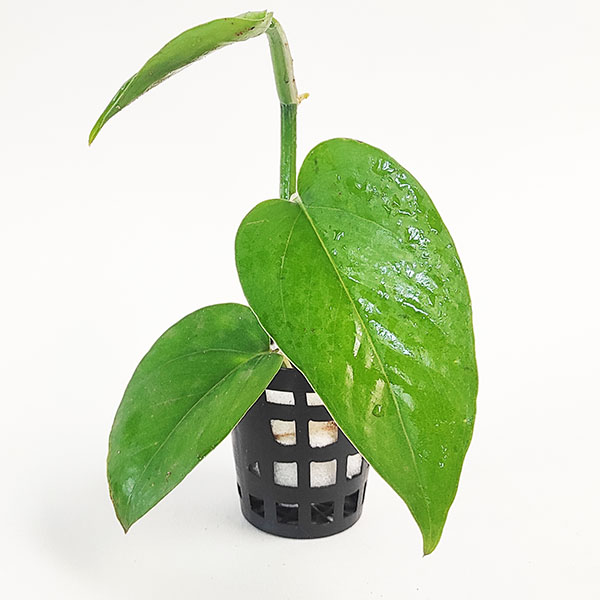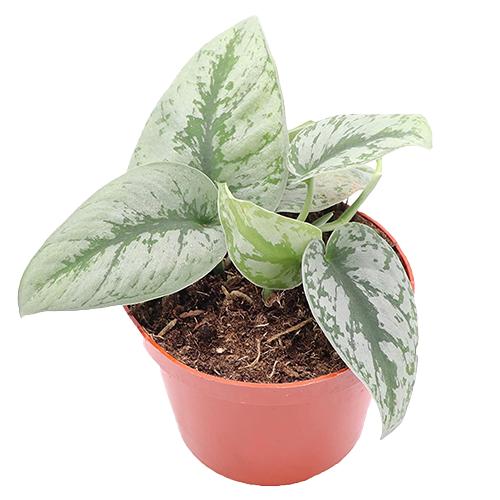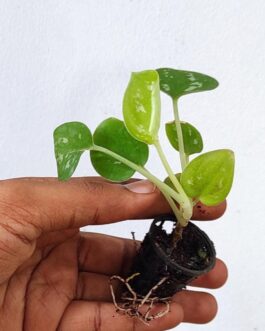Satin Pothos – Scindapsus Pictus
Original price was: ₹200.₹49Current price is: ₹49.
16 in stock
Description
Quantity: single plant (minimum two leaves)
Scindapsus pictus is a widely appreciated houseplant, and for good reason. Its vining nature makes it a great option for those looking for a hanging plant, while its soft, silver-green splotched leaves are bound to catch the eye! Satin Pothos care is a breeze and this species can be grown by beginners.
Keep reading for everything you need to know about satin Pothos care.
| Name(s) (common, scientific) | Satin Pothos, silver Philodendron, silver vine, Pothos pictus, silk Pothos, Scindapsus pictus |
| Difficulty level | Easy |
| Recommended lighting | Indirect |
| Water | Let dry slightly |
| Soil type | Potting soil |
Satin Pothos natural habitat
This vining plant is naturally found in various countries in South East Asia. Since the best way to figure out how to care for a houseplant is to keep its natural habitat in mind, let’s go ahead and deduce what we can about satin Pothos care from its growth habits.
The natural way for a Scindapsus pictus to grow is similar to Pothos or Philodendron, which might be one of the reasons the species are confused so frequently.
The plant is found in areas with plenty of trees, where it supports itself by growing in a non-parasitical way along their trunks. Alternatively, if there are no trees to be found, Scindapsus pictus might instead be found strewn across the forest floor.
Did you know? Satin Pothos, silver Philodendron, silver vine, silk Pothos… what do all these names have in common? Surprising as it may seem, they’re all used for this exact same houseplant. The strangest part is that it’s actually neither a type of Pothos nor a type of Philodendron. Due to this confusing common naming, it’s now one of the many houseplants with names that are more misleading than helpful.
Light
What the above information on Scindapsus pictus’ natural growth habits tells us about its lighting needs, is that this species is similar to many other rainforest plants in the houseplant hobby in that it’s not used to receiving direct sun. After all, tree canopies would naturally drown out most light far before it could reach its leaves.
In the house, this means it’s not a good idea to place your Scindapsus pictus near a window that receives a lot of direct sun every day (south-facing, in the Northern Hemisphere). Instead, find a window that gets indirect light or place the plant a bit further away from the light source. You can also help protect it with a sheer curtain.
Because this species doesn’t need a lot of light in general, it will do well in most areas in your home as long as there’s some light coming in. This is also one of the reasons Scindapsus pictus is quite a popular choice for offices and public spaces. It will grow just fine under just artificial lighting as well!
Temperature
The areas Scindaptus pictus naturally grows in are characterized by their tropical temperatures. In your home, you should therefore try to keep the plant away from cold to prevent damage. It’s not frost tolerant at all: most sources actually recommend a minimum temperature of 15 °C/59 °F. Regular room temperature works well.
Be sure to keep your Scindapsus pictus away from drafty windows or cold sheds, especially if you’re in an area where it gets chilly during the winter months!
Satin Pothos soil & planting
Soil
Scindapsus pictus is not a difficult plant when it comes to soil choice. To imitate the tropical conditions it naturally grows in, choose something that holds some moisture while letting excess water drain in order to prevent rot.
A normal potting soil should work just fine in most cases. If it drains too fast, you can add some type of peat-replacement, like coco coir. If you find things draining too slow, a handful of perlite might prove helpful.
Planting
Nothing complicated here either. As long as the pot you’re using has proper drainage (in the form of a drainage hole at the bottom), your Scindapsus pictus should be just fine. Plastic nursery pots are a popular choice, as they have drainage holes to let excess water drain but do still hold moisture relatively well due to their plastic edges.
Like the popular Pothos, there are two ways to grow Scindapsus pictus: you can either let it hang, or make it grow upwards. The former results in a small-leaved plant with impressively long vines, whereas the latter results in larger leaves. You can imitate the way the species naturally grows on tree trunks by letting it climb on a plant totem.
Watering satin Pothos
Figuring out a watering schedule that works for your Scindapsus pictus isn’t too hard and the plant is quite forgiving. This is part of what makes this species such a great option for beginners. It’s not possible to tell you exactly how often you should water yours, though, as it all depends on the conditions in your home.
Just keep an eye on the plant’s soil to pinpoint when it needs water. It should be lightly dry at the top and lightly moist near the bottom. Bone dry and you’ve waited too long, still soggy and you should water less next time!
In practice. this will come down to roughly once a week in most cases. Do keep in mind that the plant will need more water during the growing months (spring and summer) than the dormant period.
Satin Pothos fertilizer
In order to optimize your satin Pothos care and keep the plant growing at its full potential, you can use a regular houseplant fertilizer about once a month.
Be sure to stop fertilizing once winter rolls around and the plant stops growing. It won’t be able to use the fertilizer during this period and feeding can actually cause root burn!
Propagating satin Pothos
Propagating Scindapsus pictus is a breeze. Any piece of stem with a few leaves will regrow just fine as long as there are root nodes included. Propagate this plant in water or just place cuttings straight into the soil. The latter will take a little longer, but prevents the possibility of the cuttings being shocked by the transfer from water to soil once you pot them up.
Not sure how to go about propagating your Scindapsus pictus? It’s pretty much identical to propagating Pothos. Scindapsus pictus cutting grown in soil.
Only logged in customers who have purchased this product may leave a review.










Reviews
There are no reviews yet.